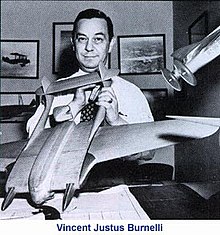Vincent Burnelli
Vincent Justus Burnelli | |
|---|---|
 Burnelli circa 1940-1950 | |
| Born | November 22, 1895 |
| Died | June 22, 1964 (aged 68) |
| Resting place | Pinelawn Cemetery Farmingdale, New York |
| Education | St. Peter's College, New Jersey |
| Occupation | Aircraft designer |
| Known for | Lifting body, flying wing |
| Spouse | Hazel Goodwin |
| Children | Barbara Burnelli Adams, Patricia Burnelli Kimmins Steinhauser |
Vincent Justus Burnelli (November 22, 1895 – June 22, 1964) was an American aeronautics engineer, instrumental in furthering the lifting body and flying wing concept.[1]
Biography
[edit]Burnelli was born on November 22, 1895, in Temple, Texas.[1]
With his friend, John Carisi, he designed his first airplane in 1915, at Maspeth, Queens, New York. The open biplane was first demonstrated at the old Hempstead Plains Aviation Field, later to become Roosevelt Field. A few years later, he designed a "night fighter" in the hopes that it would be used as a combat aircraft in World War I. His hopes were not realized, but he did sell the plane to the New York City Police Department, when plans were made to create an aerial police operation.
In 1919, Burnelli refined his ideas about aircraft design, after he had built what is believed[by whom?] to have been the world's first large commercial airliner, the Lawson L-4, in Milwaukee, Wisconsin, for the Lawson Airlines.
Flying wing/lifting body
[edit]
Burnelli was one of the first American designers to capitalize on the "flying wing" mystique. In the 1920s, he produced two biplane transports with large, airfoil-shaped fuselages that contributed a considerable portion of the airplane's lift. His goal was to develop a more efficient airplane that could carry a large payload. Although Burnelli referred to his lifting body transports as "flying wings", his production aircraft invariably retained some kind of a tail, frequently supported by upswept booms that extended rearward. More accurately, Burnelli had a "lifting body" design, rather than a true "flying wing" where all major aeronautical components are housed within the wing.
Burnelli's first monoplane, the CB-16, appeared in 1928. This aircraft and subsequent Burnelli types produced into the 1940s had certain features in common:
- The engines were close together and ahead of the cabin structure
- The airfoil fuselage section, which provided 50 percent lift at cruising speed, housed the passenger cabin and the pilot's and mechanic's compartments.
More than 60 percent of the weight and strength of the aircraft structure surrounded and protected the passenger cabin section for maximum resistance to telescoping.
Burnelli maintained that his lifting design had unparalleled safety, economic and operational advantages over conventional transport designs. His design philosophy was supported by many prominent civil and military aviation experts well into the late 1940s, but he failed to gain the political and economic backing that would have ensured public acceptance of his unconventional designs. Through various partnerships, he worked for and created a diverse number of companies that would produce his designs, most of which saw the light as experimental or prototype aircraft. The elusive production contracts that he so wanted, continued to elude him. His last design, the CBY-3 Loadmaster, was manufactured by Canada Car and Foundry in Montreal. The sole prototype was extensively tested but failed to gain a production contract.
Later years
[edit]Moving to Southampton, New York, Burnelli remained tireless in his determination to promote his airfoil-shaped fuselage transport planes. In 1955, he adapted his final design, the Burnelli CBY-3 Loadmaster, to carry an expedition of 20 passengers and 41 sled dogs, along with their equipment, to the North Pole, but the enterprise was canceled. Until his death in 1964 at the age of 68, Vincent Burnelli championed his "flying wing" designs.
Legacy
[edit]The Loadmaster continued to fly regularly as a commercial airliner both in northern Canada and South America. Acquired with design rights by Airlifts, Inc. of Miami, Florida, it went to Venezuela and returned to Burnelli Avionics for refitting with Wright R-2600 engines. The CBY-3 finally ended its flying days at Baltimore's airport in Maryland. In 1964, the quintessential Burnelli "flying wing" air transport was retired to the New England Air Museum in Windsor Locks, Connecticut, where it remains.
Burnelli designs
[edit]- Continental KB-1 (1915)
- Burnelli (Lawson Airlines)
- Remington-Burnelli (airliner) SEE Burnelli, wide, airfoil-shaped fuselage w 2 Liberty 12 (400 hp) engines, 78' span;, 22.25' lg[2][3]
- Burnelli RB-1 (1921)
- Burnelli RB-2 Air freighter (1924)
- Burnelli CB-16 Chapman Airliner (1928)[4]
- Burnelli UB-20 (1929)
- Burnelli GX-3 (1929)
- Uppercu-Burnelli Aeromarine-Klemm Amphibian seaplane (1930)
- Burnelli UB-14 (1935)
- Cunliffe-Owen Aircraft[5] OA-1 Clyde Clipper (licence-built British version of the UB-14) (1939)
- Burnelli XCG-16 cargo glider (1943)
- Burnelli CBY-3 Loadmaster (1944) built in Canada by Canadian Car and Foundry
References
[edit]- ^ a b "Vincent J. Burnelli and His Flying Fuselage". HistoryNet. 12 June 2006. Retrieved 25 May 2021.
- ^ "American airplanes: Ra - Ri". www.aerofiles.com. Retrieved 2024-06-19.
- ^ "The Remington-Burnelli Airliner Biplane"[dead link] FLIGHT page 505, July 28, 1921 -- also see pages 506 and 507
- ^ "Auto Soars in Plane In Fuel Tests Popular Science, May 1935, accessed 2024-06-20
- ^ "1936 | 3056 | Flight Archive". www.flightglobal.com. Archived from the original on 2012-10-13.
